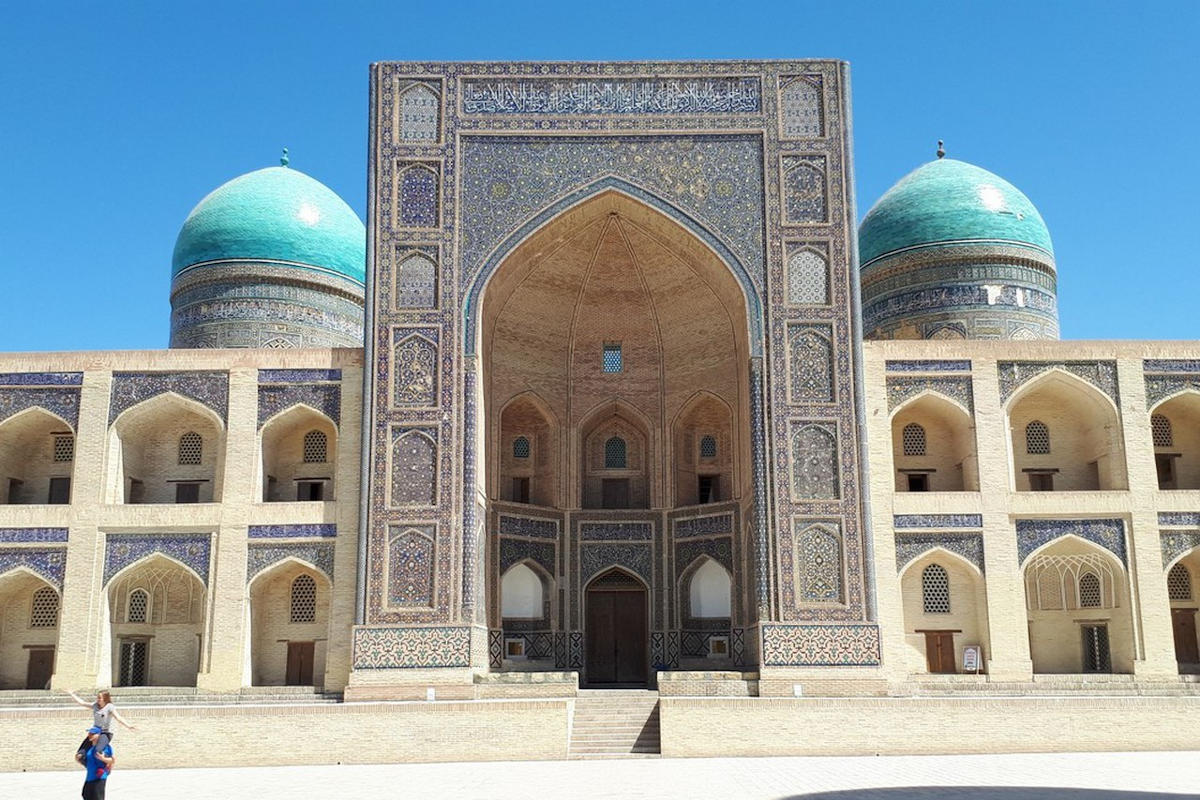Bukhara - Miri Arab Madrasah
Miri Arab Madrasah is an Islamic educational and religious institution from the 16th century in Bukhara. It has been included in the UNESCO World Heritage List.

Poi-Kalon Madrasah is a part of the architectural ensemble Poi-Kalon (it includes three buildings – Madrasah, Mosque and Minaret). Miri Arab Madrasah is located on the opposite side of Kalon Mosque.
Miri Arab Madrasah in Bukhara was built in the first third of the 16th century by order of Sheikh Sayyid Abdullah al-Yamani Khazaramavti. This sheikh once had a great influence on the ruler Ubaidullah Khan. An enormous fortune was spent on the construction of the mosque: one version – 3,000 Persian prisoners were sold into slavery for this purpose and another version – the resources were obtained in military campaigns.
Even historians cannot agree on the exact date of the construction of the Madrasah. Some say that it is 1535 – 1536 and the rest – that at that time Miri Arab Madrasah had already been built, because before his death Sayyid Abdullah al-Yamani Khazaramavti (he died in 1526) ordered to bury him in the territory of the Madrasah. It is possible that Miri Arab was rebuilt in the years 1535 – 1536, therefore this date is given. By the way, exactly after the death of Sayyid Abdullah al-Yamani Khazaramavti, the Madrasah received the name Miri Arab, which means “property of the Arab”.
Although the construction was carried out in accordance with the existing structural scheme, the ensemble was executed with a certain scope and freedom. The Madrasah has 111 fairly spacious hujras, each consisting of a small living room, a living room with cupboards and a storage room.
The spacious aivans served as summer auditoriums. The grave of the founder and builder of the Madrasah took the place of a large darshana on the main façade.
The size of the Miri-Arab madrasah is 73 x 55 metres.
Its majestic façade is raised on a high platform above the grounds of the Kalon Mosque and is completely covered with mosaics. It is surrounded by massive corner towers. In the centre of the façade there is a high entrance portal with a semi-circular octopus vault and two-storey loggias on the sides.
The corner halls are crowned by turquoise domes. Their high cylindrical drums are decorated with tile mosaics that form the borders and epigraphic texts.
There are two large halls at the corners of the front façade of the Madrasah. In the southern hall there is an audience and a mosque, while in the northern hall there is a necropolis of Sheikh Miri Arab (“Prince of the Arabs”) – this was the name of Sayyid Shams ad-Din Abdullah al-Arabi, who came from Yemen.
In the 80s of the XV century Miri Arab moved to Central Asia and became an apprentice of Khodscha Ahrar. He was the head of the Muslims of Bukhara and enjoyed great authority at the courts of Muhammad Shaybani and Ubaidullah Khan.
Ubaidullah Khan revered Miri Arab as his spiritual teacher. Ubaidullah Khan was the educated man of his time. He freely recited the Koran, wrote commentaries in Old Uzbek, wrote several Sufi tracts, was a gifted singer and musician.
Until 1920, the Madrasah was located in the Emirate of Bukhara (a state situated on the territory of today’s Uzbekistan, Tajikistan and part of Turkmenistan). After 1920, when the Soviet Union came to power, the Madrasah was closed. In 1945, however, Mufti Eshon Bobokhon succeeded in discovering Miri Arab. Until 1989 she was the only Madrasah in the USSR (another one from 1956 to 1961 was in Tashkent, but it was closed because of the accident of the building).
The study in the Madrasah took 9 years, if the first-year student already had a secondary secular education – 4 years. The programme covered secular and religious subjects and was supervised by the Council for Religious Affairs of the Government of the USSR. There were very few students in the Madrasah: between 40 and 80 people studied there every year.
The sights of the Madrasah are the internal open portals, located on the axes of the court and used as summer classrooms. Carved mosaics with predominantly plant ornaments and complex handwriting in the form of a Sülüs were used in the exterior decoration.
It was this Madrasah that gave the Islamic Orient the most enlightened personalities in religious studies, poetry and culture.
In the meantime, the Miri Arab Madrasah has become one of the most important religious educational institutions in Bukhara. It is here that the future Muftis (Islamic jurists) are introduced to all the subtleties of Islam.
